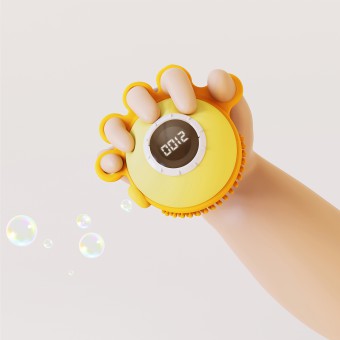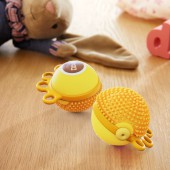DESIGN NAME:
Bubble
PRIMARY FUNCTION:
Hand Trainer
INSPIRATION:
Children with Down syndrome and hand injuries often encounter challenges like disinterest and demotivation during the rehabilitation process. Given this, the object of this design is to develop a product that not only fosters fun but also proves to be efficient in promoting rehabilitation, so that this group of children would engage with the training interactively and get motivated for rehabilitation.
UNIQUE PROPERTIES / PROJECT DESCRIPTION:
The Bubble Kids Hand Trainer was tailored for the rehabilitation needs of those children with Down syndrome and hand injuries. Unlike traditional rehabilitation devices, this trainer merges the features of a bubble machine with spring grip training to offer a unique combination of entertainment and rehabilitation efficacy. Backed by the pressure-sensing technology, the device makes bubbles when a child's finger applies a specific force, guiding them in making grip rehabilitation exercises properly.
OPERATION / FLOW / INTERACTION:
After the ball is filled with bubble water, a child can insert the fingers into the rings and grip the ball until bubbles appear. The gripping strength is proportional to the number of bubbles produced. The integrated pressure-sensing chips and counter keep track of the effective presses, guiding children in applying a proper force and encouraging them to proceed with hand training.
PROJECT DURATION AND LOCATION:
The project kicked off on May 2021 and wrapped up on December 2023 in China.
|
PRODUCTION / REALIZATION TECHNOLOGY:
Crafted from skin-friendly silicone material with a textured surface to enhance grip and stimulate the joints and acupoints of children's hands, the Bubble Kids Hand Trainer comes with five pressure-sensing chips that are linked up to five fingers.
SPECIFICATIONS / TECHNICAL PROPERTIES:
60mmX60mmX60mm
TAGS:
Fun,hand grip training, bubbles,spring grip,rehabilitation training
RESEARCH ABSTRACT:
This project is intended to study how to stimulate children's interest in rehabilitation training and improve their hand strength and mobility through an emotional design approach. To conduct the research, various data collection and research tools were used, including online literature, parental interviews, field observations, CAD computer-aided modeling, and product prototypes to evaluate the interaction feedback to and from internal components such as the main body, pressure sensor, counter, and bubble blowing unit.
CHALLENGE:
The main focus of this design endeavor is to make a trade-off between the form and function of the hand trainer, aiming to achieve a captivating and rehabilitative effect that arouses the children’s attention. However, there are several key challenges that need to be addressed. For example, how to evaluate the efficacy of the trainer, and how to accurately capture behavioral and emotional response data from children in use.
ADDED DATE:
2024-02-27 08:37:46
TEAM MEMBERS (4) :
Aoru Yang, Jing Li, Jack Wang and Hao Yu
IMAGE CREDITS:
Yanching Institute of Technology, 2023.
|









